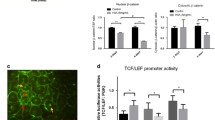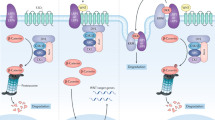Abstract
Background
β-Catenin is a multi-functional protein involved in nephrogenesis and also plays important roles in renal injury. Here, the expression of β-catenin was investigated in the proximal renal tubular epithelial cells in cisplatin (CDDP)-induced acute kidney injury (AKI) and chronic kidney injury (CKI), because CDDP-induced renal lesions were characterized by proximal renal tubular epithelial degeneration/regeneration and subsequent interstitial fibrosis.
Methods
F344 rats were treated with CDDP. The expression of β-catenin and proliferative (Ki67) or fibrogenic [vimentin, α-smooth action (α-SMA)] markers was analyzed by immunolabeling.
Results
β-Catenin, vimentin and Ki67 were not seen in the proximal renal tubules of control rats. Interestingly, in CDDP-induced AKI, the regenerating proximal renal tubular epithelial cells reacting strongly with Ki67 expressed membranous or cytoplasmic β-catenin and also showed a positive reaction to vimentin but not to α-SMA. In CDDP-induced CKI, the epithelial cells of abnormally dilated or atrophied renal tubules did not react to β-catenin or Ki67, but showed positive reactions to vimentin and α-SMA. β-Catenin mRNAs were significantly increased in AKI and significantly decreased in CKI.
Conclusion
Newly expressed β-catenin in the proximal renal tubules after AKI may participate in functional regeneration. In CKI, epithelial cells of abnormal renal tubules did not express β-catenin but reacted to vimentin, and α-SMA might indicate the epithelial–mesenchymal transition (EMT) formation, because α-SMA is usually expressed in myofibroblasts forming via EMT. The presence or absence of β-catenin expression would become a marker for the EMT phenomenon in progressive renal fibrosis.






Similar content being viewed by others
References
MacDonald BT, Tamai K, He X. Wnt/β-catenin signaling: components, mechanisms, and diseases. Dev Cell. 2009;17:9–26.
Tian X, Liu Z, Niu B, et al. E-cadherin/β-catenin complex and the epithelial barrier. J Biomed Biotechnol. 2011. https://doi.org/10.1155/2011/567305.
Clevers H. Wnt/β-catenin signaling in development and disease. Cell. 2006;127:469–80.
Park JS, Valerius MT, McMahon AP. Wnt/β-catenin signaling regulates nephron induction during mouse kidney development. Development. 2007;134:2533–39.
He W, Dai C, Li Y, et al. Wnt/β-catenin signaling promotes renal interstitial fibrosis. J Am Soc Nephrol. 2009;20:765–76.
Zhou D, Li Y, Lin L, et al. Tubule-specific ablation of endogenous beta-catenin aggravates acute kidney injury in mice. Kidney Int. 2012;82:537–47.
Xiao L, Zhou D, Tan RJ, et al. Sustained activation of Wnt/β-catenin signaling drives AKI to CKD progression. J Am Soc Nephrol. 2016;27:1727–40.
Razzaque MS, Taguchi T. Cellular and molecular events leading to renal tubulointerstitial fibrosis. Med Electron Microsc. 2002;35:68–80.
Schiffrin EL, Lipman ML, Mann JF. Chronic kidney disease: effects on the cardiovascular system. Circulation. 2007;116:85–97.
Ide M, Yamate J, Kuwamura M, et al. Immunohistochemical analysis of macrophages and myofibroblasts appearing in hepatic and renal fibrosis of dogs. J Comp Patho. 2001;124:60 – 9.
Kuwahara Y, Ohba Y, Kitoh K, et al. Association of laboratory data and death within one month in cats with chronic renal failure. J Small Anim Pract. 2006;47:446–50.
Coresh J, Selvin E, Stevens LA, et al. Prevalence of chronic kidney disease in the United States. JAMA. 2007;298:2038–47.
Yamate J, Okado A, Kuwamura M, et al. Immunohistochemical analysis of macrophages, myofibroblasts, and transforming growth factor-β localization during rat renal interstitial fibrosis following long-term unilateral ureteral obstruction. Toxicol Pathol. 1998;26:793–801.
Yamate J, Sato K, Ide M, et al. Participation of different macrophage populations and myofibroblastic cells in chronically developed renal interstitial fibrosis after cisplatin-induced renal injury in rats. Vet Pathol. 2002;39:322 – 33.
Hinz B, Phan SH, Thannickal VJ, et al. Recent developments in myofibroblast biology: paradigms for connective tissue remodeling. Am J Pathol. 2012;180:1340–55.
Kida Y, Duffield JS. Pivotal role of pericytes in kidney fibrosis. Clin Exp Pharmacol Physiol. 2011;38:467–73.
Smith SW, Chand S, Savage CO. Biology of the renal pericyte. Nephrol Dial Transplant. 2012;27:2149–55.
LeBleu VS, Taduri G, O’Connell J, et al. Origin and function of myofibroblasts in kidney fibrosis. Nat Med. 2013;19:1047–53.
Galichon P, Hertig A. Epithelial to mesenchymal transition as a biomarker in renal fibrosis: are we ready for the bedside? Fibrogenesis Tissue Repair. 2011. https://doi.org/10.1186/1755-1536-4-11.
Tennakoon AH, Izawa T, Kuwamura M, Yamate J. Pathogenesis of type 2 epithelial to mesenchymal transition (EMT) in renal and hepatic fibrosis. J Clin Med. 2016. https://doi.org/10.3390/jcm5010004.
Yamate J, Sato K, Machida Y, et al. Cisplatin-induced rat renal interstitial fibrosis; a possible pathogenesis based on the data. J Toxicol Pathol. 2000;13:237–47.
Miller RP, Tadagavadi RK, Ramesh G, Reeves WB. Mechanisms of cisplatin nephrotoxicity. Toxins. 2010;2:2490–518.
Yamamoto E, Izawa T, Juniantito V, et al. Relationship of cell proliferating marker expressions with PGE2 receptors in regenerating rat renal tubules after cisplatin injection. J Toxicol Pathol. 2010;23:271–75.
Bonventre JV. Dedifferentiation and proliferation of surviving epithelial cells in acute renal failure. J Am Soc Nephrol. 2003;14:S55–61.
Terada N, Karim MR. Izawa T, et al. Immunolocalization of β-catenin, E-cadherin and N-cadherin in neonate and adult rat kidney. J Vet Med Sec. 2017;79:1785–90.
Smeets B, Boor P, Dijkman H, et al. Proximal tubular cells contain a phenotypically distinct, scattered cell population involved in tubular regeneration. J Pathol. 2012;229:645–69.
Muskhelishvili L, Latendresse JR, Kodell RL, Henderson EB. Evaluation of cell proliferation in rat tissues with BrdU, PCNA, Ki-67(MIB-5) immunohistochemistry and in situ hybridization for histone mRNA. J Histochem Cytochem. 2003;51:1681–88.
Stacey DW. Cyclin D1 serves as a cell cycle regulatory switch in actively proliferating cells. Curr Opin Cell Biol. 2003;15:158 – 63.
Stark K, Vainio S, Vassileva G, McMahon AP. Epithelial transformation of metanephric mesenchyme in the developing kidney regulated by Wnt-4. Nature. 1994;372:679–83.
Terada Y, Tanaka H, Okado T, et al. Expression and function of the developmental gene Wnt-4 during experimental acute renal failure in rats. J Am Soc Nephrol. 2003;14:1223–33.
Wang Z, Havasi A, Gall JM, et al. Beta-catenin promotes survival of renal epithelial cells by inhibiting Bax. J Am Soc Nephrol. 2009;20:1919–28.
Bernard P, Fleming A, Lacombe A, et al. Wnt4 inhibits beta-catenin/TCF signalling by redirecting beta-catenin to the cell membrane. Biol Cell. 2008;100:167–77.
Brossa A, Papadimitriou E, Collino F, et al. Role of CD133 molecule in Wnt response and renal repair. Stem Cells Transl Med. 2018;7:283–94.
Boivin FJ, Sarin S, Lim J, et al. Stromally expressed β-catenin modulates Wnt9b signaling in the ureteric epithelium. PLoS One. 2015;10:e0120347.
Acknowledgements
This work was supported partly by the JSPS KAKENHI Grant Numbers 26292152 (to Yamate), by the Platform Project for Supporting Drug Discovery and Life Science Research (Basis for Supporting Innovative Drug Discovery and Life Science Research (BINDS) from AMED under Grant Number JP18am0101123, and by the Ichiro Kanehara Foundation for the Promotion of Medical Science and Medical Care (The 31st International Student Grant to Karim).
Author information
Authors and Affiliations
Corresponding author
Ethics declarations
Conflict of interest
There are no conflicts of interest.
Ethical considerations
Animal experiments were carried out in accordance with the guidelines set by the Graduate School of Life and Environmental Sciences, Osaka Prefecture University. The protocol was approved by the ethical committee for the Care and Use of Experimental Animals of Osaka Prefecture University (Permit No. 21-16 and 25-85) and conformed to the Guidelines for the Conduct of Animal Experimentation of the Ministry of Health, Labor and Welfare Standards relating to the Care and Management of Experimental Animals and the Act on Welfare and Management of Animals, Japan. All efforts were made to minimize animal suffering. Specimens from humans were not used.
About this article
Cite this article
Terada, N., Karim, M.R., Izawa, T. et al. Expression of β-catenin in regenerating renal tubules of cisplatin-induced kidney failure in rats. Clin Exp Nephrol 22, 1240–1250 (2018). https://doi.org/10.1007/s10157-018-1583-1
Received:
Accepted:
Published:
Issue Date:
DOI: https://doi.org/10.1007/s10157-018-1583-1




